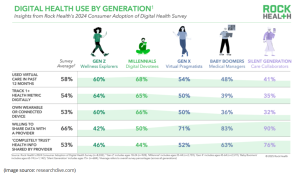The Pew Research Center defines members of Gen Z as anyone born between 1997 and 2012, making the average age for the second-youngest generation between 13 and 28 years old. Because Gen Z grew up with the internet as part of their daily lives, these young people are often referred to as “digital natives” who are comfortable navigating digital technology.
But how has Gen Z’s exposure to the internet and technology impacted their preferences and habits around telehealth? In this blog post we’ll explore trends surrounding Gen Z and virtual health and how health systems can engage this generation moving forward.
How Gen Z Approaches Health and Wellness
While the youngest Gen Zers still have their doctor’s visits and health decisions made by their parents or guardians, others have already entered the workforce and are making their own choices.
Technology has greatly impacted how young people approach their personal wellness and seek health advice. According to a survey by McKinsey & Company, Gen Z respondents are “less reliant on any single source for health-related content compared with other generations,” including their providers. While 59% of baby boomers report turning to their doctors for health information, only 42% of Gen Z felt the same. For Gen Z, social media platforms including YouTube, Instagram and TikTok, are a close second (38%).
How Gen Z’s Virtual Care Use Compares to Other Generations
According to a 2024 Consumer Adoption of Digital Health Survey by Rock Health, Millennials were most likely to have used virtual care in the last 12 months, with 68% have done so, compared to 60% of Gen Z. However, of the 60% of Gen Zers who used virtual care in the past 12 months, one-third accessed it via texting, the highest of any generation; 11% accessed virtual care for mental health care via texting, app, or website-based messaging, the same percentage as those who got this care over the phone or live video. Those in Gen Z are also the top generation using AI for health questions, with 29% using AI tools like ChatGPT for health care needs, with 18% “diagnosing” their conditions and 11% using it to explore treatment options.

Meeting Gen Zers Where They Are
As a generation that prioritizes health and wellness and is comfortable using technology to explore health-related topics, there are many opportunities for health care organizations to connect with Gen Zers through telehealth. Here are some things to consider as you engage with this generation of patients:
- If you aren’t already, provide telehealth options for your patients. Beyond the Covid-19 pandemic era, young patients continue to value the convivence and flexibility that telehealth provides.
- Develop a social media plan that provides preventative health care information. Because Gen Z is already looking to social media platforms for this information, sharing accurate and trustworthy heath content will help educate and potentially attract new patients.
- Use interactive tools and personalized features. Gen Z expects technology to be not only functional but engaging as well. Explore tools that enhance virtual care with features like live chat for quick questions, digital symptom checkers, and personalized health dashboards. If you’re not already, incorporate features like appointment reminders via text, pre-registration forms, and post-visit summaries. Virtual care should feel interactive, tailored, and responsive to their needs — just like the apps they use every day.
Investing in online platforms, digital technologies, and other telehealth tools can help encourage young people to be more involved in their health and wellness needs, improve their experiences, and strengthen trust in health providers.

